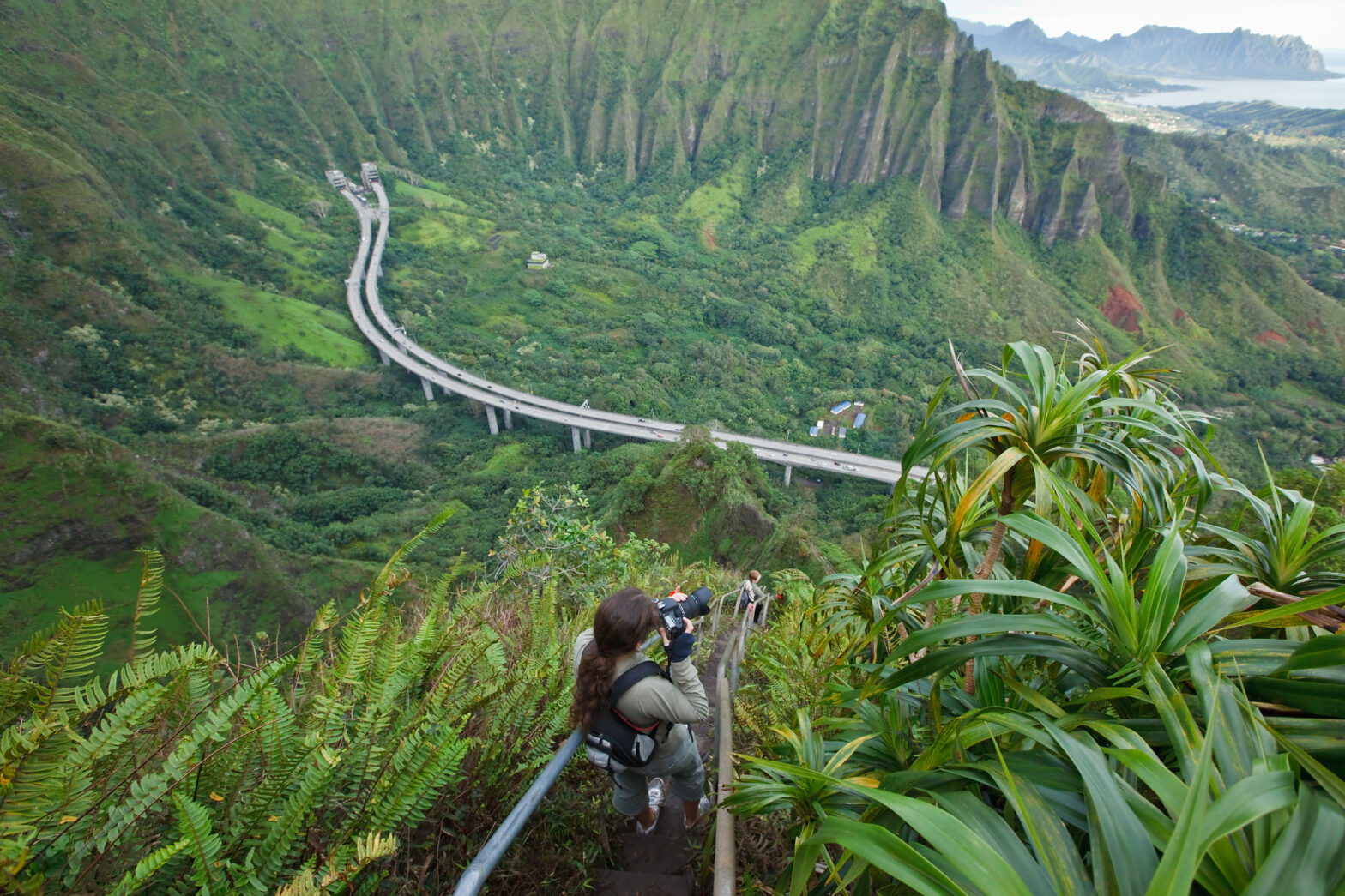**Disclaimer: The Haiku Stairs in Hawaii have been closed since 1987 due to safety concerns. It is illegal to hike the stairs itself. Hiking enthusiasts are encouraged to check with local officials for the latest updates on the Stairway to Heaven in Hawaii.**
Hiking Haiku Stairs, also known as the Stairway to Heaven in Hawaii, is a ILLEGAL, thrilling and challenging adventure that offers breathtaking views of the Hawaiian landscape. This iconic trail is located on the island of Oahu and is famous for its steep staircase that ascends the Ko’olau mountain range. To properly enjoy the trail and to ensure a safe trip, background research on its elevation, permits, regulations, and more is necessary. The following article gathers that information for you in one spot so you can enjoy the Haiku Stairs for yourself.
Trail Overview
Haiku Stairs is situated in the Haiku Valley near Kaneohe, on the island of Oahu, Hawaii. The trail features approximately 3,922 steps that were initially constructed during World War II to access a radio station atop the mountains. The steep ascent covers a distance of about 2.5 miles (4 kilometers) and offers a challenging elevation gain of around 2,800 feet (853 meters).
Difficulty level and trail conditions vary along the route. The staircase itself can be extremely steep, and hikers should be prepared for steep inclines, uneven steps, and occasional exposure to heights. Additionally, the trail can be muddy and slippery, especially after rainfall. It is important to be physically prepared and have prior hiking experience to tackle this trail safely. Recommended hiking seasons are typically during the drier months from May to October. However, weather conditions can change rapidly, and hikers should always check the forecast and trail conditions before embarking on a hike.
Permits and Regulations
The Haiku Stairs have been closed since 1987. There have been long-standing safety concerns with the stairs, and as recent as June 2022 discussion has revolved around removing them altogether. However, there are many scenic trails around the area which still make it a popular destination for hikers. Local tour companies know the area well and are able to navigate many of the trails in the surrounding area.
Trail Highlights and Points of Interest
Despite the current closure, it is worth noting the trail’s remarkable highlights and points of interest. Haiku Stairs holds historical significance as it served as a vital communication link during World War II. Exploring the remnants of the military infrastructure and learning about its role in the island’s history adds a layer of cultural interest to the hike.
Along the way, hikers encounter stunning viewpoints, such as the Haiku Valley and the Ko’olau Mountain Range, offering panoramic vistas of the surrounding landscape. The trail also winds through lush forests, providing glimpses of unique flora and fauna that thrive in the region’s tropical climate.
Is There a Legal Way To Hike Haiku Stairs?
As readers have already gathered, it is illegal to hike the Haiku Stairs for safety reasons. Doing so may mean, quite literally, stepping on the Stairway to Heaven. However, there is another trail that will take avid hikers close enough to view the stairs. It is called the Moanalua Valley Trail.
The Moanalua Valley Trail starts at Moanalua Valley Road and runs for 2.5 miles. This trail will take hikers to the top portion of the stairs, the very summit of the mountain, where they will then be able to look down on the infamous Haiku Stairs trail and see what it is all about.
Safety Considerations
When hiking Haiku Stairs or any challenging trail, safety should be a top priority. One should always use essential hiking gear and equipment. Such things as a backpack, a first aid kit, a headlamp, a whistle, a multi-tool, and extra layers of clothing are crucial for safety and comfort.
Proper clothing and shoes are also highly recommended. Wear moisture-wicking and breathable clothing suitable for the weather conditions. Choose sturdy hiking boots or trail shoes that provide ankle support and traction. This means checking the weather before you go, wearing the correct footwear (no slippahs) and bringing lots of water and snacks .
As with any hike, hydration is going to be a key factor: Make sure to carry an adequate supply of water as there are no reliable water sources along the trail. Hydrate frequently and drink enough to stay properly fueled throughout the trails.
Nowadays, maps are not the only essential navigation tools one ought to keep in hand. Bring a compass, and/or a GPS device to navigate the trail. Familiarize yourself with the route before starting the hike and keep track of your progress.
Hawaii is home to a variety of unique and sometimes endangered species. Be respectful and avoid disturbing wildlife. Keep a safe distance and never feed or approach them.
One other, very important aspect to all of this: one ought to familiarize themselves with emergency procedures and have emergency contact numbers readily available. Let someone know your hiking plans and expected return time.
Planning and Preparation
Thorough planning and preparation are crucial for a successful and safe hiking experience. Gather as much information as possible about the trail, its difficulty level, and the current status. Learn from the experiences of other hikers to better understand what to expect.
Hikers should also work on fitness levels and increase cardio work at elevation. Build up gradually before attempting this challenging hike. Incorporate cardiovascular exercises, strength training, and hiking practice to prepare your body for the physical demands of the trail.
Plan your hike carefully, including start time, estimated hiking duration, and potential rest breaks. It is essential to have a realistic schedule to ensure you have enough time to complete the hike safely.
Pack lightweight and nutritious food items that provide sustained energy. Carry enough food and water to last the entire duration of the hike. Include snacks for additional fuel during breaks.
Leave No Trace principles should be followed along with responsible hiking practices. Respect the environment by packing out all trash, minimize noise pollution, and stay on designated trails to preserve the natural beauty of the area.
Navigation and Trail Markings
Understanding trail markers and signs is crucial for staying on the right path. Although Haiku Stairs is currently closed, it is important to be familiar with trail navigation.
Familiarize yourself by researching online the various trail markers for this specific area. In this case, perusing social feeds like Instagram may prove very helpful, as one will be able to see photos from the actual trail itself.
When on the trail, remember to carry a detailed map, use a guidebook or GPS device to navigate accurately, and track significant waypoints and landmarks with your smartphone camera. Label these markers under a particular tag when saving the photo to a phone so they may be easily recalled when needed.
People Ask: Haiku Stairs Trail Hike
Q: Can I hike Haiku Stairs now?
A: As of June 2022, the Haiku Stairs trail is officially closed to the public. It is important to respect the regulations and adhere to the closure for safety reasons.
Q: Why is Haiku Stairs closed?
A: The closure of Haiku Stairs is primarily due to safety concerns and trespassing issues. The stairs are in a deteriorating condition, and accessing the trail without proper authorization can lead to accidents and injuries.
Q: Can I obtain a permit to hike Haiku Stairs?
A: Permits to hike Haiku Stairs are not available to the public due to the trail’s closure. It is advised to explore alternative hiking options on Oahu that are open and authorized for public use.
Q: Are there any alternative trails with similar views to Haiku Stairs?
A: Yes, there are alternative trails on Oahu that offer stunning views similar to Haiku Stairs. Consider exploring other popular hikes like the Makapu’u Lighthouse Trail or the Pu’u Manamana Trail for equally breathtaking vistas.
Q: Is it dangerous to hike Haiku Stairs?
A: Hiking Haiku Stairs can be dangerous due to its steep and deteriorating condition. Trespassing on closed trails is not only illegal but also poses significant risks to personal safety.
Q: Are there any legal alternatives to access Haiku Stairs?
A: As of June 2022, there are no legal alternatives to access Haiku Stairs. The closure is strictly enforced, and hikers should explore other authorized trails on the island.
Q: Can I see the Haiku Stairs from a distance without hiking the trail?
A: Yes, it is possible to catch distant views of Haiku Stairs from various lookout points or hikes in the vicinity. However, keep in mind that these views may not offer the same up-close experience as hiking the trail.
Q: When will Haiku Stairs reopen?
A: The reopening of Haiku Stairs is uncertain, and it is advisable to stay updated with the latest information from local authorities or hiking organizations. Monitor official announcements regarding the trail’s status.
Q: Are there any penalties for hiking Haiku Stairs illegally?
A: Hiking Haiku Stairs illegally can result in fines, penalties, and legal consequences. Trespassing on closed trails not only jeopardizes personal safety but also undermines efforts to preserve and protect the environment.
Q: What other hikes can I consider on Oahu?
A: Oahu offers a wide range of stunning hiking trails. Consider exploring popular alternatives like the Diamond Head Summit Trail, Manoa Falls Trail, or the Wiliwilinui Ridge Trail for beautiful hikes with different difficulty levels and scenic views.
Please note that the answers provided are based on the information available up until June 2022. It is crucial to stay updated with the latest regulations and announcements regarding Haiku Stairs.
Hiking Haiku Stairs, or the Stairway to Heaven, offers the adventure of a lifetime for experienced hikers. Stunning views and a challenging climb await here in Hawaii. While the trail is currently closed to the public, it is important to respect the regulations and prioritize safety when exploring any trail. By adequately preparing, conducting thorough research, and following responsible hiking practices, you can ensure a memorable and safe hiking experience. Remember to stay informed about the current status of the trail and explore alternative hiking options on Oahu that offer equally beautiful adventures.





